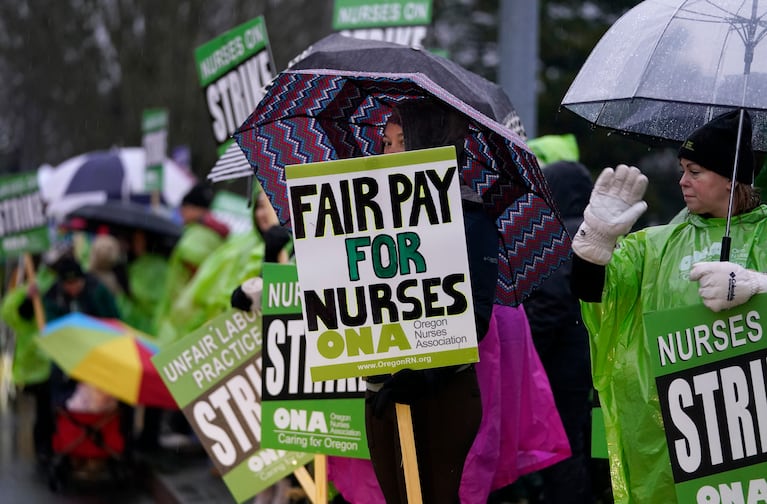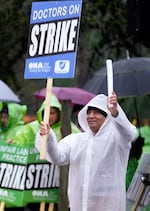
Obstetric hospitalists Darleen Dodson, MD, left, and Jennifer Lincoln, MD, center, stand on the picket line outside of Providence St. Vincent Medical Center, in Portland, Ore., Jan. 10, 2025.
Kristyna Wentz-Graff / OPB
Thousands of workers at Providence Oregon walked off the job Friday morning. The strike, which impacts all eight Providence hospitals in the state as well as six women’s clinics, includes nearly 5,000 nurses and more than 100 physicians and advanced practitioners.
Providence said in a press conference Friday that about 10% of unionized physicians had chosen to work, along with more than a hundred union-represented nurses.
The Oregon Nurses Association announced on Dec. 30 they would walk out Jan. 10 if a deal could not be reached. The two sides have been in bargaining for more than a year and had been working with federal mediators.
It is the first time in recent state history that doctors have gone on strike.
Those on strike include obstetrician-gynecologists at six Providence women’s clinics in the Portland area and hospitalists and palliative care physicians at Providence St. Vincent Medical Center.
The physicians said they’re striking in protest of what they see as systemic understaffing, which leads them to care for more patients than they feel is safe.
“We’re people who pride ourselves on overcoming great adversity to show up and take care of patients,” said Dr. Charlie Saltalamacchia, who works at a Providence Women’s Clinic, on the picket line Friday. “So for doctors to be leaving work and telling our patients to seek care elsewhere, so that we can demonstrate how drastically desperate we are in this moment with our negotiations with Providence, I think it speaks volumes to how difficult the working conditions have become.”
Some on strike Friday also cited concerns about job security, pointing to recent decisions Providence has made to sell parts of its operation, or to seek investment from private equity.
“We need to protect our jobs from being outsourced,” said Dr. Darlene Dodson, an obstetric hospitalist at St. Vincent Medical Center. “We’ve seen them replace other departments without any provocation other than monetary ones ... we’re a fairly small department and I feel that Providence could replace us.”
ONA has accused Providence of stonewalling on core priorities like improving staffing and reducing out of pocket health care costs, and violating labor law by refusing to bargain with nurses after it received their 10-day strike notice, while asking to continue bargaining with doctors.
Providence said it has offered nurses a 20% pay increase over 3 years and improved benefits, and has accused the Oregon Nurses Association of delay tactics and letting contracts expire “with the intent of forcing strikes.”
Gov. Tina Kotek said she has called on all parties to return to the bargaining table.
“Providence wasted 10 days when they could have been at the table making progress towards a comprehensive resolution of their labor dispute,” Kotek said in a statement Friday. “Oregonians are already experiencing disruptions to care. All parties must return to the table immediately to resolve their disagreements.”
In response to the governor, Providence reiterated that their focus was on preparing for the walkout, and could not afford the time to bargain.
At a press conference Friday, Providence Oregon chief executive Jennifer Burrows said the organization was not yet ready to resume bargaining with nurses, but would reach out to federal mediators once hospital operations were stabilized.
“We recognize that conversation is the way to make it through, to find compromises and we need to get back to the table quickly,” she said.
Burrows acknowledged that hospital staffing is a challenge, not only for Providence but nationwide. Providence has hired more nurses in response to Oregon’s nurse staffing law, she said.
Dr. Ben Leblanc, chief executive of Providence Medical Group Oregon, said historically, physicians worked closely with managers to develop the right staffing plans for their work, and to figure out how to handle dips and surges in patients.
Translating that system into a union contract has been difficult, Leblanc said.
“We’re committed to it, patients are sicker, and we have to work together with the physicians to solve that problem,” he said.
Burrows confirmed that any nurses who wish to work at any point during the strike must report to Providence by 8 or 9 p.m. tonight, a policy that might violate striking workers' rights.
“We have seen more ONA caregivers cross, and have come to work today to care for their community, than we anticipated,“ Burrows said.
The situation is different for striking physicians, Leblanc said. They should reach out to their medical director “if and when they’re ready to come back.”
Providence officials said they’ve been able to hire 2,000 replacement workers to fill in for striking nurses, using an agency. The effort to recruit temporary physicians from within and outside Providence has been more difficult.
During the strike, Providence has consolidated its womens' clinics from six locations in the greater Portland metro area down to just two - an eastside and westside location.
With fewer providers available, the clinics are able to schedule about one-third of the patients they would normally see, LeBlanc said.
“We’re really taking it day-by-day, filling out the schedule, calling patients a couple of days in advance to see how this develops over the next few days,” he said.
Providence has said that St. Vincent is equipped to handle roughly 85% of the patients that it typically sees during the work stoppage. In advance of the strike, St. Vincent stopped accepting transfer patients. The hospital leadership informed nurses it would not open its cardiac ICU overflow area during the strike, and said there may be more patients waiting in the emergency room than normal.
Correction: the original version of this story misstated the number of clinics involved in the strike. Staff at six women’s clinics are participating in the walkout. OPB regrets the error.





















